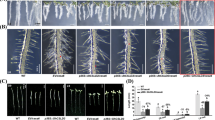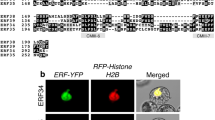Abstract
Key message
AtTIP1 physically and genetically interacts with AtCESA3. AtCESA3 undergoes S-acylation, possibly mediated by AtTIP1, suggesting a specific role of AtTIP1 in cellulose biosynthesis and plant development.
Abstract
S-acylation is a reversible post-translational lipid modification of proteins catalyzed by protein S-acyl transferases (PATs). S-acylation is important for various biological molecular mechanisms including cellulose biosynthesis. Cellulose is synthesized by the cellulose synthase A (CESA) complexes (CSCs) at the plasma membrane. However, specific PAT involving in cellulose biosynthesis has not been identified and the precise mechanism by which PAT regulates the CESAs is largely unknown. Here, we report isolation of tip1-5, an allele of Tip Growth Defective1 (AtTIP1/AtPAT24) with a premature stop codon. tip1-5 genetically interacts with ixr1-2, a point mutant of AtCESA3 which encodes a catalytic subunit of CSC synthesizing primary wall cellulose. We show that AtTIP1 physically interacts with AtCESA3. AtCESA3 undergoes S-acylation, which is possibly mediated by AtTIP1, suggesting a functional relationship between AtTIP1 and AtCESA3. Moreover, the interfascicular fiber cells in the primary inflorescence stems of tip1-5 ixr1-2 double mutant contain thinner cell walls and significantly less crystalline cellulose compared to the single mutants. These results highlight the positive regulation of AtTIP1 in cellulose biosynthesis, and a specific role of AtPAT in plant development.





Similar content being viewed by others
Data availability
Enquiries about data availability should be directed to the authors.
References
Bashline L, Li S, Gu Y (2014) The trafficking of the cellulose synthase complex in higher plants. Ann Bot 114:1059–1067
Bashline L, Li S, Zhu X, Gu Y (2015) The TWD40-2 protein and the AP2 complex cooperate in the clathrin-mediated endocytosis of cellulose synthase to regulate cellulose biosynthesis. Proc Natl Acad Sci USA 112:12870–12875
Batistic O (2012) Genomics and localization of the Arabidopsis DHHC-cysteine-rich domain S-acyltransferase protein family. Plant Physiol 160:1597–1612
Bosca S, Barton CJ, Taylor NG, Ryden P, Neumetzler L, Pauly M, Roberts K, Seifert GJ (2006) Interactions between MUR10/CesA7-dependent secondary cellulose biosynthesis and primary cell wall structure. Plant Physiol 142:1353–1363
Carroll A, Mansoori N, Li S, Lei L, Vernhettes S, Visser RG, Somerville C, Gu Y, Trindade LM (2012) Complexes with mixed primary and secondary cellulose synthases are functional in Arabidopsis plants. Plant Physiol 160:726–737
Chen H, Zou Y, Shang Y, Lin H, Wang Y, Cai R, Tang X, Zhou JM (2008) Firefly luciferase complementation imaging assay for protein-protein interactions in plants. Plant Physiol 146:368–376
Clough SJ, Bent AF (1998) Floral dip: a simplified method for Agrobacterium-mediated transformation of Arabidopsis thaliana. Plant J 16:735–743
Desprez T, Juraniec M, Crowell EF, Jouy H, Pochylova Z, Parcy F, Hofte H, Gonneau M, Vernhettes S (2007) Organization of cellulose synthase complexes involved in primary cell wall synthesis in Arabidopsis thaliana. Proc Natl Acad Sci USA 104:15572–15577
Gao C, Yu CK, Qu S, San MW, Li KY, Lo SW, Jiang L (2012) The Golgi-localized Arabidopsis endomembrane protein12 contains both endoplasmic reticulum export and Golgi retention signals at its C terminus. Plant Cell 24:2086–2104
Harris DM, Corbin K, Wang T, Gutierrez R, Bertolo AL, Petti C, Smilgies D-M, Estevez JM, Bonetta D, Urbanowicz BR, Ehrhardt DW, Somerville CR, Rose JKC, Hong M, DeBolt S (2012) Cellulose microfibril crystallinity is reduced by mutating C-terminal transmembrane region residues CESA1A903V and CESA3T942I of cellulose synthase. Proc Natl Acad Sci USA 109:4098–4103
Hemsley PA, Kemp AC, Grierson CS (2005) The tip growth defective1 S-acyl transferase regulates plant cell growth in Arabidopsis. Plant Cell 17:2554–2563
Hemsley PA, Taylor L, Grierson CS (2008) Assaying protein palmitoylation in plants. Plant Method 4(1):124–128
Hemsley PA, Weimar T, Lilley KS, Dupree P, Grierson CS (2013) A proteomic approach identifies many novel palmitoylated proteins in Arabidopsis. New Phytol 197:805–814
Hu H, Zhang R, Feng S, Wang Y, Wang Y, Fan C, Li Y, Liu Z, Schneider R, Xia T, Ding SY, Persson S, Peng L (2018) Three AtCesA6-like members enhance biomass production by distinctively promoting cell growth in Arabidopsis. Plant Biotechnol J 16:976–988
Huang L, Li X, Zhang W, Ung N, Liu N, Yin X, Li Y, McEwan RE, Dilkes BP, Dai M, Hicks GR, Raikhel NV, Staiger CJ, Zhang C (2020) Endosidin20 targets the cellulose synthase catalytic domain to inhibit cellulose biosynthesis. Plant Cell 32:2141–2157
Iwanaga T, Tsutsumi R, Noritake J, Fukata Y, Fukata M (2009) Dynamic protein palmitoylation in cellular signaling. Prog Lipid Res 48:117–127
Kumar M, Turner S (2015a) Plant cellulose synthesis: CESA proteins crossing kingdoms. Phytochemistry 112:91–99
Kumar M, Turner S (2015b) Protocol: a medium-throughput method for determination of cellulose content from single stem pieces of Arabidopsis thaliana. Plant Methods 11:46
Kumar M, Wightman R, Atanassov I, Gupta A, Hurst CH, Hemsley PA, Turner S (2016) S-acylation of the cellulose synthase complex is essential for its plasma membrane localization. Science 353:166–169
Li Y, Qi B (2017) Progress toward understanding protein S-acylation: prospective in plants. Front Plant Sci 8:346
Li J, Mahajan A, Tsai MD (2006) Ankyrin repeat: a unique motif mediating protein-protein interactions. Biochemistry 45:15168–15178
Li S, Lei L, Gu Y (2013) Functional analysis of complexes with mixed primary and secondary cellulose synthases. Plant Signal Behav 8:e23179
Li S, Bashline L, Lei L, Gu Y (2014) Cellulose synthesis and its regulation. Arabidopsis Book 12:e0169
McFarlane HE, Doring A, Persson S (2014) The cell biology of cellulose synthesis. Annu Rev Plant Biol 65:69–94
Nixon BT, Mansouri K, Singh A, Du J, Davis JK, Lee JG, Slabaugh E, Vandavasi VG, O’Neill H, Roberts EM, Roberts AW, Yingling YG, Haigler CH (2016) Comparative structural and computational analysis supports eighteen cellulose synthases in the plant cellulose synthesis complex. Sci Rep 6:28696
Park S, Song B, Shen W, Ding SY (2019) A mutation in the catalytic domain of cellulose synthase 6 halts its transport to the golgi apparatus. J Exp Bot 70:6071–6083
Persson S, Paredez A, Carroll A, Palsdottir H, Doblin M, Poindexter P, Khitrov N, Auer M, Somerville CR (2007) Genetic evidence for three unique components in primary cell-wall cellulose synthase complexes in Arabidopsis. Proc Natl Acad Sci USA 104:15566–15571
Polko JK, Kieber JJ (2019) The regulation of cellulose biosynthesis in plants. Plant Cell 31:282–296
Polko JK, Barnes WJ, Voiniciuc C, Doctor S, Steinwand B, Hill JL Jr, Tien M, Pauly M, Anderson CT, Kieber JJ (2018) SHOU4 proteins regulate trafficking of cellulose synthase complexes to the plasma membrane. Curr Biol 28:1–9
Ryan E, Grierson CS, Cavell A, Steer M, Dolan L (1998) TIP1 is required for both tip growth and non-tip growth in Arabidopsis. New Phytol 138:49–58
Scheible WR, Eshed R, Richmond T, Delmer D, Somerville C (2001) Modifications of cellulose synthase confer resistance to isoxaben and thiazolidinone herbicides in Arabidopsis Ixr1 mutants. Proc Natl Acad Sci USA 98:10079–10084
Schiefelbein J, Calway M, Masucci J, Ford S (1993) Pollen tube and root-hair tip growth is disrupted in a mutant of Arabidopsis thaliana. Plant Physiol 103:979–985
Schneider R, Tang L, Lampugnani ER, Barkwill S, Lathe R, Zhang Y, McFarlane HE, Pesquet E, Niittyla T, Mansfield SD, Zhou Y, Persson S (2017) Two complementary mechanisms underpin cell wall patterning during xylem vessel development. Plant Cell 29:2433–2449
Sorek N, Poraty L, Sternberg H, Buriakovsky E, Bar E, Lewinsohn E, Yalovsky S (2017) Corrected and Republished from: Activation status-coupled transient S-acylation determines membrane partitioning of a plant Rho-related GTPase. Mol Cell Biol 37:e00333-e1317
Srivastava V, Weber JR, Malm E, Fouke BW, Bulone V (2016) Proteomic analysis of a poplar cell suspension culture suggests a major role of protein S-acylation in diverse cellular processes. Front Plant Sci 7:477
Suzuki S, Li L, Sun Y-H, Chiang VL (2006) The cellulose synthase gene superfamily and biochemical functions of xylem-specific cellulose synthase-like genes in Populus trichocarpa. Plant Physiol 142:1233–1245
Taylor NG, Howells RM, Huttly AK, Vickers K, Turner SR (2003) Interactions among three distinct CesA proteins essential for cellulose synthesis. Proc Natl Acad Sci USA 100:1450–1455
Turnbull D, Hemsley PA (2017) Fats and function: protein lipid modifications in plant cell signalling. Curr Opin Plant Biol 40:63–70
Waadt R, Kudla J (2008) In planta visualization of protein interactions using bimolecular fluorescence complementation (BiFC). CSH Protoc. https://doi.org/10.1101/pdb.prot4995
Zhang Y, Nikolovski N, Sorieul M, Vellosillo T, McFarlane HE, Dupree R, Kesten C, Schneider R, Driemeier C, Lathe R, Lampugnani E, Yu X, Ivakov A, Doblin MS, Mortimer JC, Brown SP, Persson S, Dupree P (2016) Golgi-localized STELLO proteins regulate the assembly and trafficking of cellulose synthase complexes in Arabidopsis. Nat Commun 7:11656
Zhang X, Mi Y, Mao H, Liu S, Chen L, Qin F (2020) Genetic variation in ZmTIP1 contributes to root hair elongation and drought tolerance in maize. Plant Biotechnol J 18:1271–1283
Zhong R, Morrison WH III, Freshour GD, Hahn MG, Ye ZH (2003) Expression of a mutant form of cellulose synthase AtCesA7 causes dominant negative effect on cellulose biosynthesis. Plant Physiol 132:786–795
Acknowledgements
We thank Dr. Yunde Zhao and Dr. Yongbiao Xue for insightful discussion, Drs. Sha Li and Shanwei Li for tip1-4 seeds, Dr. Feng Qin for tip1-3 seeds, Dr. Jianmin Zhou for LCI vector, Dr. Yuxin Hu for the Chemiluminescent Imaging System, Dr. Caiji Gao for suggestions and EMP12 plasmid. We thank Ms. Fengqin Dong from the Plant Science Facility of the Institute of Botany, Chinese Academy of Sciences, and Ms. Lizhen Song for their excellent technical assistance. This work was supported by the projects from the National Natural Science Foundation of China (NSFC) (31970309; 31171389), National Key Research and Development Program of China (2016YFD0100400), Strategic Priority Research Program of the Chinese Academy of Sciences (XDA26030302), and STS Program of the Chinese Academy of Sciences (STS Program KFJ-STS-ZDTP-076 to Y.C.). Madhu Shudan Thapa Magar was supported by the PhD fellowship of CAS-TWAS President’s Fellowship program.
Funding
National Natural Science Foundation of China (Grant Nos. 31970309, 31171389). National Key Research and Development Program of China (2016YFD0100400), Strategic Priority Research Program of the Chinese Academy of Sciences (XDA26030302), and STS Program of the Chinese Academy of Sciences (STS Program KFJ-STS-ZDTP-076 to Y.C.).
Author information
Authors and Affiliations
Contributions
YC designed the research. LZ, MSTM and YW performed experiments. YC, LZ and MSTM analyzed data, and YC, LZ and MSTM wrote the paper. All authors read and approved the final manuscript.
Corresponding author
Ethics declarations
Conflict of interest
The authors declare that they have no competing interests.
Additional information
Publisher's Note
Springer Nature remains neutral with regard to jurisdictional claims in published maps and institutional affiliations.
Accession numbers
Sequence data of the genes described in this article can be found in the GenBank/EMBL data libraries under the accession numbers: AT5G20350 (AtTIP1), AT5G05170 (AtCESA3), AT4G32410 (AtCESA1), and AT5G64740 (AtCESA6).
Lu Zhang and Madhu Shudan Thapa Magar contributed equally as co-first authors to this work.
Supplementary Information
Below is the link to the electronic supplementary material.
Rights and permissions
About this article
Cite this article
Zhang, L., Thapa Magar, M.S., Wang, Y. et al. Tip growth defective1 interacts with cellulose synthase A3 to regulate cellulose biosynthesis in Arabidopsis. Plant Mol Biol 110, 1–12 (2022). https://doi.org/10.1007/s11103-022-01283-8
Received:
Accepted:
Published:
Issue Date:
DOI: https://doi.org/10.1007/s11103-022-01283-8




